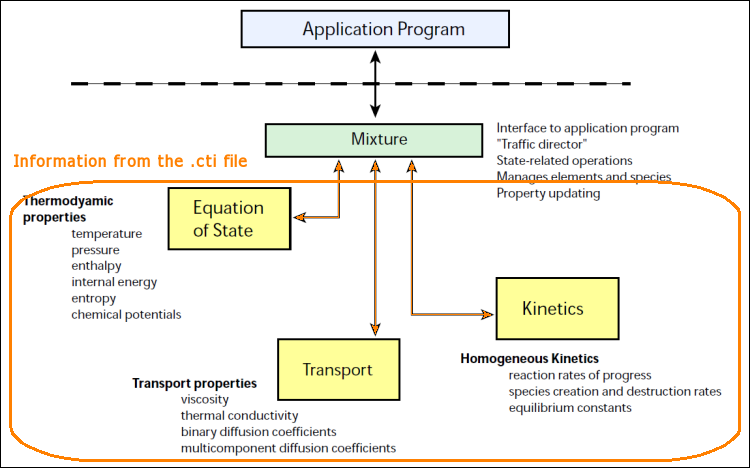Navigation
WARNING
There is currently some clean up going on so files may not be accessible, we apologise for that. Everything should be back to normal in a week or two.
Introducing Cantera
General description
"Cantera is a suite of object-oriented software tools for problems involving chemical kinetics, thermodynamics and/or transport processes"
Cantera allows to create objects representing phases of matter, interfaces between these phases, reactors, 1-dimensional reacting flows, etc. It can be used to calculate chemical equilibriums, simulate autoignition, or the propagation of 1-dimensional flames, for example.
Most of the program is written in C++ but interfaces are provided with other languages such as Python, Matlab and Fortran 90/95. Python is advised over all the other languages since it is designed to be easy to use and script compilation is faster. (Cantera under a Matlab environment would be the best way to go but a commercial license is required.)
In a nutshell
Phases of matter under Cantera are defined by using input files in either a .cti or a .xml format. Either one of these format will be used for the combustion schemes provided on this website. All the elements, species, reactions, transport models, interfaces (for multiphase flows) are described in this file including all thermodynamics and transport properties linked to the species and reactions.
The code has been developped in C++ using classes in which most functions and relevant datas are defined; although some functionalities are linked to Fortran subroutines.
The user needs to script his simulations, using one of the interfacing languages, to create an application program. In all the scripts, the input mechanism file is first imported as a C++ object, so that functions can be applied to it. An index of all the classes and functions that are available in Cantera can be found here.
Below, a scheme summarizing the relationships between the imported phases of matter and the Cantera software:

CERFACS version of Cantera
The CERFACS modified version of Cantera is intended to "test" kinetic schemes prior to an implementation in the CFD solver AVBP. In AVBP a simplified transport based upon constant Schmidt and Prandtl numbers and a simple fitting power law for the viscosity is employed. Moreover, a thickened flame combustion model is employed. Finally, when ARCs are used, the chemistry induced timestep should remain "reasonable". The CERFACS version of Cantera enables to address all these questions through:
- An implementation of the same simplified transport model (for more information, consult the AVBP handbook).
- Specific kinetic managers for each ARC featuring QSS species.
- The implementation of constant and dynamic thickening of the flame front. Several flame sensors can be employed.
As such, it is possible, for example, to generate laminar premixed thickened flame profiles with ARC mechanisms and simplified transport properties. Frequently visit the 'Updates' section, to keep informed about the latest developments in the CERFACS version of the code !
Useful documentation
CERFACS Resources:
- A quick presentation of Cantera.
- Tutorials from the CERFACS' Cantera formation.
- Help for the tutorials from the CERFACS' Cantera formation.
- Slides from the MACADAM presentation of september 2017: "Chemistry at CERFACS" (Not very useful for non-CERFACS people !).
Web Resources:
- Official Cantera Documentation: This site contains documentation for the current stable version of Cantera.
- The Cantera SourceForge site: Distribution of Cantera releases and binary installers. It also contains the project history.
- Official Cantera discussion group: This site has a message board for discussions amongst Cantera users. This is a lifesaver !
- The Cantera Developers Group: Limited access site where developers can discuss development ideas.
- A Doxygen peruser of classes and functions.